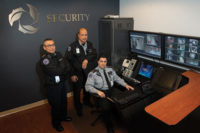Not exactly Maxwell Smart’s Cone of Silence, there was a time when security staff members monitoring blurry CCTV video images on CRTs would look through a kind of cone device to cut down on monitor glare.
Nowadays, there are huge video walls in command and control rooms and security video monitoring has moved way beyond staring at a screen. Live monitoring now relies on watching pieces of action and clips generated by simple or sophisticated analytics. There has been a noticeable shift from live monitoring to retrieval of images for forensics, investigation and business management needs.
Then there is the growing attraction of video monitoring remotely on a smartphone, tablet or laptop as well as remote monitoring through a third party service.
Mobility has become a sought-after feature for many enterprise security leaders. Security officers can carry a smartphone and review video clips of an alarmed situation as they proceed to the site. A chief security officer or security director can tap into his or her security video feed through a laptop equipped with Wi-Fi and using a secure Web connection. Particularly in retail, for instance, a store owner can now look into a facility from anywhere, not just for security but also for management, training and safety purposes.
Sharing Monitored Video
In some cases, such as colleges, schools and public housing complexes, campus police and city law enforcement officers have the ability to access security video, often through a wireless mesh network.
Overall, mobility is now seen as crucial. For example, when system integrators and dealers were recently asked about the importance of mobile devices, generally, to their clients’ security operations, almost nine in 10 (88 percent) said, “Very important; my customers are using them now for security monitoring/alerts.”
Certain types of crime and local ordinances also can lead to security video monitoring solutions.
There is video verification, which, in some cases, goes beyond sending a video clip to a smartphone. For utilities fearing metal theft at remote facilities or to protect construction sites and on-site equipment, an effective solution is a wireless system: Motion activates an integrated night vision camera and sends a short video of an intruder over the cell network to a monitoring station or site manager or security. An example is Videofied, which operates for months on one set of batteries, indoors or outside, with no wires or power.
Another version of video verification links to local ordinances, which mandate certain additional steps by a central station to cut down on false alarms. While the monitoring service may not be viewing video in real-time, an intrusion alarm can trip video sent to the monitoring firm to confirm the incident before dispatching the police.
Also among security video monitoring solutions is what some call virtual guard patrols.
One source of this approach, Acadian Monitoring Services works with enterprise security leaders to perform virtual guard patrols on a scheduled, emergency or as-needed basis. The firm points out that the method of performing guard patrols results in significant human resource cost reductions for customers. It also offers two-way voice in conjunction with video monitoring. Voice capability through a speaker and/or a microphone can be installed on premises to help gather information or deter an event in progress.
Hosted Video Approach
Then there is video surveillance as a service (VSaaS), what some call hosted or managed video services. System integrators and some dealers see this solution helping streamline an enterprise’s security video operation.
At least at this time, VSaaS may not be everyone’s security video monitoring
solution.
Hosted systems are more to the liking of enterprises that need general surveillance in normal resolution. It’s often viewed as a static system to quickly get video from anywhere in the world. According to an executive at one major national integrator, hosted is for someone with the need for a simple deployment. And, while some integrators aim at the larger enterprise clients, more often hosted security video creates solutions for small- and medium-sized clients or for large enterprises with dispersed offices or stores.
Of course, there are benefits and tradeoffs for VSaaS as a video monitoring solution. For instance, such new-age services boast:
• Low up front cost
• Less emphasis on hardware
• Easier integration with access control and intrusion systems
• Video recording and retrieval anywhere, anytime on desktop, notebook and mobile devices
• Video secure from fire, flood, theft or system failure
• Standardized, centrally managed platform reduces support expense
A hosted video solution, coupled with the transition to IP, can also open a door to more sophisticated technology applications for the securing of special events.
Giant integrator ADT last year rolled out its own ADT hosted video service for the retail industry with video recording and management centrally handled. Using an Internet connection and IP cameras, retailers access video remotely from anywhere. This gives them the convenience of centralized video storage without the cost, equipment and maintenance of storing and managing their own video on-site.
Closing the Loop with Integrators
Other tech sources also are responding with hosted services aimed first at the integrator.
Earlier this year, for example, Honeywell Security sent up what it calls MaxPro Cloud, a hosted service that gives organizations access to their video surveillance anywhere there is an Internet connection, and without the need for IT expertise or challenging firewall configurations.
Another source, CheckVideo has what it calls a professional service option, where channel partners deliver a cloud-based intelligent video surveillance monitoring and recording solution to enterprise security clients who monitor their own video. It detects presence of people and vehicles, not just motion, to reduce nuisance alerts.
There is basic agreement on the importance and role of security video storage in hosted and managed services. And many designs include local recording and storage. According to Jay Krone, senior director consumer and small business products division, Iomega, an EMC company, “This gives the enterprise the ability to record and store HD video locally while also providing economical access to standard resolution video data stored securely in the cloud, for instance.”
Speaking of return on investment, John Honovich of IPVM IP Video Market agrees that “hosted and managed video has the potential to make video surveillance cheaper and easier to deploy and use.” However, and in the short term, he sees it making the most impact in the small business and home markets. At his website, the consultant analyzes the products, pricing and positioning of, at the time of writing of this article, 27 diverse solutions.
Open Platform Design
Concerning open platform solutions, one example is from Western Kentucky University. “We can expand our solution and support our clients without worrying about having to babysit the software,” points out Jeppie Sumpter, lead network engineer at Western Kentucky University. Thanks to a Milestone open platform, Sumpter tweaked the solution, installed add-ons and created specialized integrations to support different scenarios. The central management application allows the team to perform most management tasks from a central location, making it possible for a small team with limited resources to maintain such a large deployment with ease.
Several years back, the IT division at Western Kentucky University decided to deploy and manage its own video surveillance system. Today, the network team acts like a third-party integrator. “We’re essentially providing a hosted and managed service for the diverse groups within the university,” says Sumpter. “It is all taking place under a unified system, a single federated solution, where we can keep things separate where they should be separate.”
As a first step to individualized security video monitoring, “we developed a mobile field survey kit that allows us to capture images, showing the client exactly what they would see with the finished product, including the viewing angles, matching resolution, etc.,” Sumpter explains.
When it comes to integrated monitoring, for instance, the Western Kentucky video system links with campus emergency phones. Pan-tilt-zoom cameras are placed in strategic locations. When someone activates an emergency phone, live camera feeds for that location display on the monitor wall.
Many advanced security video monitoring solutions are being developed at airports.
For instance, the Orlando Sanford International Airport (SFB), known as Central Florida’s Gateway to the Sun, is one of the busiest airports in the United States.
Although SFB employed a commercial-grade analog CCTV system to monitor security issues, this system did not have the functionality nor the capacity to properly archive video recordings. So Bryant Garrett, CFO and chief of the Sanford Airport Police Department, was responsible for overseeing the selection of a new system. His requirements were simple. First, he wanted a system that would be integrative, scalable and flexible. With these features, not only would they be able to capitalize on existing hardware investments and grow into future needs, but according to Garrett, “a non-proprietary system would [also] allow [SFB] to get competitive bids from multiple hardware vendors.” Additionally, he wanted to be able to have a multiple camera screen presentation and the functionality to manipulate PTZ cameras. Most importantly, he wanted to be able to quickly switch from live to archived videos and easily export selections of archived videos in high-quality format for other authorities to review from another monitoring station.
IP Surveillance Solution
Garrett and SFB decided that Genetec’s IP security surveillance solution, Omnicast, was the way to go.
The ability to offer viewings of live and recorded video from basically anywhere in the airport where there was access to the network was a huge plus. Terminal managers monitor aircraft traffic at the gates, ground and airline activity, passenger congestion amongst the terminal and customs clearance, and all door access throughout the large premises. Additionally, law enforcement supervises the site from a remote dispatch center, which is manned 24/7.
Proper deployment of megapixel cameras can play a significant role in monitoring of security video, especially over an extensive territory.
One example: St. Andrew’s Village in Glendowie, Auckland, New Zealand, provides multiple lifestyle options for the elderly for more than 52 years, ranging from independent living accommodations to hospital and dementia care. Management at the Village achieved the balance between security and privacy with the strategic placement of 15 megapixel IP network video cameras from Arecont Vision. By employing megapixel technology, fewer cameras were required to cover the expansive facility’s grounds. This enables security personnel to keep a close watch on activities without imposing the feeling of “big brother” that is typical when dozens of cameras occupy a site.
Chris Dale, general manager of St. Andrew’s Village for nearly 13 years, says, “To date, we have not received any complaints about the use of cameras in the Village. On the contrary, residents and staff are reassured by their presence, and [the cameras] are accepted as part of the environment in which we live and work. I am very pleased with the dependability and quality of the images produced by the cameras and [with] the efficient way those images can be viewed on our PC network at all times.”







